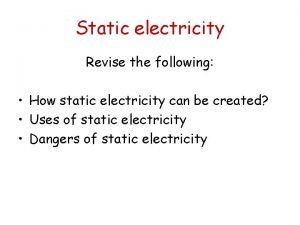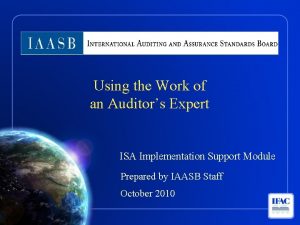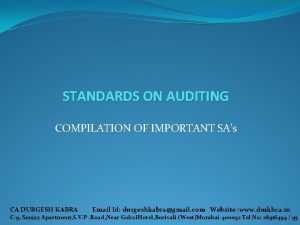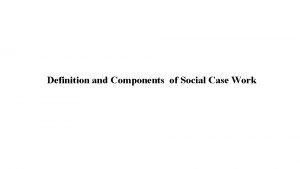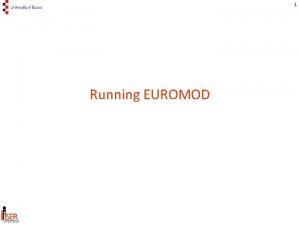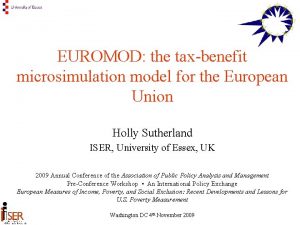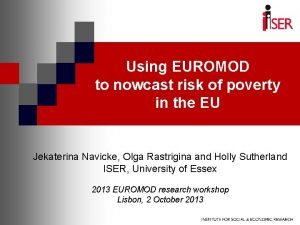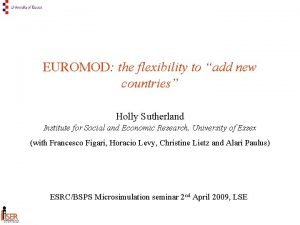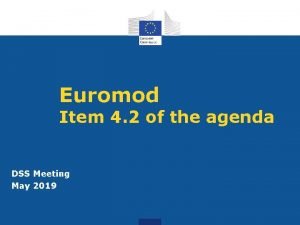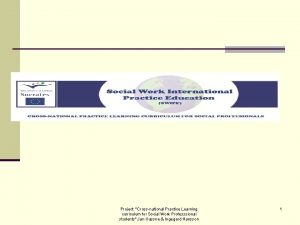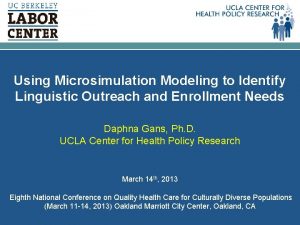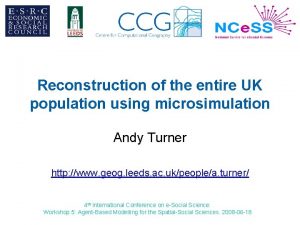CrossNational Microsimulation using EUROMOD How does it work














- Slides: 14

Cross-National Microsimulation using EUROMOD How does it work and what can it do? Holly Sutherland Institute for Social and Economic Research, University of Essex, UK 3 rd ESRC Research Methods Festival, Oxford 30 June – 3 July 2008 Session 38

2 Abstract and outline • EUROMOD is a tax-benefit microsimulation model for the EU. It is used to answer "what if" questions about the effects of fiscal and social policies, and policy reforms, on household incomes. Thus it provides "data" for analysis according to the user's own specification and question of interest. See http: //www. iser. essex. ac. uk/msu/emod/ • What are microsimulation models? • Cross-national microsimulation and EUROMOD • More about EUROMOD – Framework, design and data – Comparability across countries – Becoming a EUROMOD user

3 Microsimulation models • Microsimulation models provide data for analysis • Tax-benefit models are “static” and deal with household income, re-calculating income components (cash benefit entitlements and personal tax liabilities) under alternative scenarios – “Organised arithmetic” (lots of it…) • Consistent results for income-related indicators, including: – budgetary effects – income distributions (poverty and inequality indicators) – redistributive effects – gainers and losers – indicators of work incentives (RRs METRs) • “Budget constraints” (=incomes under alternative conditions) for modelling individual choices at the micro level • Due to changes in – Tax and benefit policies (actual, proposed or illustrative) – Household/individual characteristics or macro conditions

4 What are the main inputs? 1. Microdata on households and individuals, from income surveys or administrative data 2. Coded policy rules 3. An interface or framework for changing the rules and assumptions, usually via parameters Ø Contrast with analysis of income data taken directly from a survey – – more detail on components of taxes/benefits; can be more up-to-date; both net and gross income “what if” questions tested, consistent, documented, organised, “branded” replicable results…multi use and multi user

5 A multi-country model for cross-national research • Consistent results across countries – Comparative analysis of the effects of policies and policy reforms – EU-level outputs – Policy learning across countries: “policy swapping” Ø Understanding the effects of tax-benefit systems on different populations Ø “Borrowing” policies that seem effective in one country (e. g. UK WFTC) • But policy structures are very different across countries in several dimensions: – Policy design (e. g. rates, brackets, scales, limits) – Unit of assessment (e. g. family vs. household) – Definition of personal characteristics (e. g. who counts as a child? ) – Income assessments (e. g. tax base) – Interaction with other policies (e. g. taxable or not) • Data sources and requirements are different too.

6 EUROMOD • EUROMOD is a multi-country tax-benefit model: unique • It was built because of difficulties in making national model calculations comparable, funded by a series of EC FP projects (1998 -2008) • National models exist in most of the EU 15 and some of the 12 NMS • Typically much more flexible than national models but in some cases covering the tax-benefit systems in less detail or more selectively • 19 EU countries: EE, PL, HU, SI + EU 15 • Data either matches policy year or precedes it a few years (then uprated); three datasets (DK, IR, IT) from 1994 -96

EUROMOD base datasets for EU 15+4 (June 2008) Country Dataset Date of collection Austrian version of ECHP 1999 Belgium Panel Survey on Belgian Households 2002 Denmark European Community Household Panel 1995 Finland Income distribution survey 2001 France Budget de Famille (HBS) 2000/1 Germany German Socio-Economic Panel Greece Household Budget Survey Ireland Living in Ireland Survey 1994 Italy Survey of Households Income and Wealth 1996 Luxembourg PSELL-2 2001 Netherlands Sociaal-economisch panelonderzoek 2000 Portugal European Community Household Panel 2001 Spain EU-SILC 2005 Sweden Income distribution survey 2001 UK Family Expenditure Survey (HBS) Estonia Household Budget Survey 2005 Hungary EU-SILC 2005 Poland Household Budget Survey 2005 Slovenia Household Budget Survey / Personal Income Tax database 2005 2002 2004/5 2000/1 7

8 EUROMOD structure Policy rules (e. g. , income tax) Parameters (e. g. , tax rates) Code (e. g. , tax schedule) Micro output Runinterface Model input data (e. g. , imputed gross income) Original data (e. g. , ECHP, FES) (e. g. , net income) Tools (e. g. , summary statistics) Specific analysis

Main menu 9

Policies 10

11 Choice of data/policy years

12 Examples of EUROMOD use EUROMOD WPs illustrate types of model use – http: //www. iser. essex. ac. uk/msu/emod/workingpapers/ EM 3/02 P Feres, H Immervoll, C Lietz, H Levy, D Mantovani and H Sutherland: Indicators for Social Inclusion in the European Union: how responsive are they to macro-level changes? EM 1/04 H Immervoll, H Jacobsen Kleven, C Thustrup Kreiner, E Saez: Welfare Reform in European Countries: A Micro-Simulation Analysis EM 2/06 O Bargain and K Orsini: Beans for Breakfast? How Exportable is the British Workfare model? EM 4/06 H Levy, C Lietz and H Sutherland: A Basic Income for Europe's Children? EM 2/07 M Matsaganis and M Flevotomou: The impact of mortgage tax relief in the Netherlands, Sweden, Finland, Italy and Greece EM 6/07 F Figari, H Immervoll, H Levy and H Sutherland: Inequalities within couples: market incomes and the role of taxes and benefits in Europe EM 2/08 A Paulus and A Peichl: Effects of Flat Tax Reforms in Western Europe on Equity and Efficiency

13 Current limitations and future plans • Age of underlying data in some countries * • Direct taxes and cash benefits only; no indirect taxes or non-cash benefits * • Most contributory benefits are not fully simulated * • Static calculations only * • Benefit take up is assumed to be 100%; no tax evasion* • Tax benefit systems for 1998 (EU 15), 2001 (EU 15), 2003 (some), 2005 (some)* • EU 15 + 4 only * • Permission to access some datasets is restricted * * work is underway or planned to remedy these limitations….

14 Becoming a EUROMOD user • Training and support – 2008 Summer training course (fully booked) – Other courses? – ECASS visits to Essex (for non UK-based people) http: //www. iser. essex. ac. uk/ecass/ • • • Find out more http: //www. iser. essex. ac. uk/msu/emod/ The model itself, documentation etc can be downloaded free Data access is an issue Have a clear idea of what you want to use it for Get in touch! euromod@essex. ac. uk
 How is static electricity used to paint cars
How is static electricity used to paint cars Using system.collections.generic
Using system.collections.generic Accumulator ac
Accumulator ac Hcf from venn diagram
Hcf from venn diagram Isa 620 using the work of an expert
Isa 620 using the work of an expert Audit is important
Audit is important Work immersion portfolio design
Work immersion portfolio design Work immersion attendance
Work immersion attendance Smart work and hard work
Smart work and hard work Present simple of work
Present simple of work Models of social group work pdf
Models of social group work pdf Casework components
Casework components A group vs a team
A group vs a team Physics 03-02 potential energy and conservative forces
Physics 03-02 potential energy and conservative forces Section 4 review physical science
Section 4 review physical science
